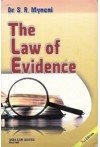- Author(s): Dr. S.R. Myneni
- Publisher: Asia Law House
- Edition: 3 Ed Rp 2024
- Approx. Pages 784 + Contents
- Format Paperback
- Approx. Product Size 24 x 16 cms
- Delivery Time 3-5 working days (within Kerala & South India) (Others 7-9 days)
- Shipping Charge Extra (see Shopping Cart)
.........................................................................................................................
Description
The whole legal edifice in India stands on four pillars: C.P.C; Cr.PC, I.P.C. and Evidence Act. Among them the Indian Evidence Act, 1872 is the important one and one of the oldest Acts, enacted in British India. However all these years, it is being amended from time to time to make it up to date to face the challenges of the changed conditions in the society. The author presents this volume of the Law of Evidence in simple language, in concise form and in lucid style. This text book on Law of Evidence is a comprehensive one based on the recent syllabus of Bar Council of India. Lal Perera, an Attonery-at-Law of Sri Lanka, who appreciated the contents of this book advised to enlarge the contents of hearsay and rule of best evidence. Hence, the author recasted the contents of the 'Rule of Hearsay Evidence' and 'The Rule of Best Evidence' and pays his gratitude to Shri Lal Perera for his appreciation and advice. This Text is the 30th contribution of the author to the law faculty and student community. The author express his profound gratitude to the authors and publishers of the references. The author is thankful to the publishers "Asia Law House, Hyderabad" for bringing out this book in attractive form. Suggestions from the readers for improvement are welcome and will be gratefully acknowledged.
.........................................................................................................................
Table of Contents
Unit - I : General Conceptions and Relevancy of Facts
Chapter 1 : Salient features of the Indian Evidence Act, 1872
Chapter 2 : Interpretation Clause - Definitions
Chapter 3 : Presumption (Presumption)
Chapter 4 : Relevancy of facts and the doctrine of Res Gestae
Chapter 5 : Motive, preparation and previous or subsequent conduct
Chapter 6 : Conspiracy
Chapter 7 : Facts not otherwise relevant become relevant [Alibi]
Chapter 8 : Damages
Chapter 9 : Right and Custom
Chapter 10 : Facts showing the state of mind, or of body of bodily feeling
Chapter 11 : Facts bearing on question whether act was accidental or international
Chapter 12 : Existence of course of business when relevant
Unit - II : Admissions, Confessions, Statements and Dying Declarations
Chapter 1 : Admissions
Chapter 2 : Confession
Chapter 3 : Statements by persons who cannot be called as witnesses
Chapter 4 : Dying Declaration
Chapter 5 : Other statements by persons who cannot be called as witness
Chapter 6 : Statements made Under Special Circumstances
Unit - III : Relevance of Judgements, Expert Testing; and Oral and Documentary Evidence
Chapter 1 : General principles about the relevancy of judgement (circumstances under
which judgements of Courts of Justice are relevant)
Chapter 2 : Expert Testimony : General Principles
Chapter 3 : Relevancy and Character evidence
Chapter 4 : Facts which need not be proved
Chapter 5 : Oral Evidence
Chapter 6 : Documentary Evidence: Primary Evidence and Secondary Evidence
Chapter 7 : Procedure or Mode of Proof of the Execution of a Document
Chapter 8 : Public Documents and Private Documents
Chapter 9 : Presumptions as to documents
Chapter 10 : General Principles regarding Exclusion of Oral by Documentary Evidence
Chapter 11 : Exclusion of Oral Evidence in Case of Ambiguous Documents
Unit - IV : Burden of Proof (ONUS PROBANDI) and Estoppel
Chapter 1 : General rules [(or) Provisions] of Burden of Proof
Chapter 2 : Specific Rules of Burden of Proof
Chapter 3 : Specific Rules of Burden of Proof in Offences against women
Chapter 4 : The Scope of the Doctrine of Judicial Notice of Presumptions
Chapter 5 : Estoppel
Unit - V : Witness, Examination & Cross Examination
Chapter 1 : Competency to Testify
Chapter 2 : Privileged Communications (Compellability of Witnesses)
Chapter 3 : Testimony of Accomplice
Chapter 4 : Examination of witness
Chapter 5 : How are Witness to unfold their knowledge to Court-Examination-in-Cheif,
Cross-Examination and Re-Examination
Chapter 6 : Leading Question
Chapter 7 : Evidence as To Matters in Writing
Chapter 8 : Questions lawful in cross-examination
Chapter 9 : To protect a witness against inproper cross-examination
Chapter 10 : Exclusion of Evidence to Contradict answers to questions testing veracity
Chapter 11 : Hostile Witness (Question by party to his own witness)
Chapter 12 : Impeaching Credit of Witness
Chapter 13 : Corrobrative Evidence
Chapter 14 : Refreshing Memory
Chapter 15 : Production of Documents
Chapter 16 : Power of the Judge to put questions or order Production
Chapter 17 : Improper Admission and Rejection of Evidence in Civia and Criminal Cases
Appendices
Appendix - A - K
Subject Index
Bibliography
.........................................................................................................................
Author Details
Dr. S.R. Myneni : M.A., M.Ed., LL.M., Ph.D., P.G. Diploma in Journalism & Mass Communication, P.G. Diploma in Econometrics, P.G. Diploma in Mathematics Ekadhika in Vedic Mathematicss, Rashtra Bhasha Praveena (Hindi) Diploma in Russian Language.

